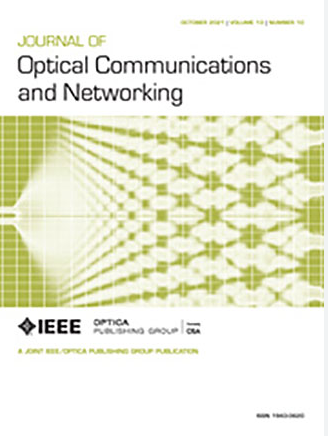具有可切换路径保护的点对多点光网络的弹性单星和无源双星光纤链路
IF 4.3
2区 计算机科学
Q1 COMPUTER SCIENCE, HARDWARE & ARCHITECTURE
引用次数: 0
摘要
本研究的重点是设计一种新的,据我们所知,考虑到灾难恢复能力的可切换网络。具体来说,它引入了一种冗余链路配置,包括提供给每个光分配终端(ODT)的单星(SS)类型作为主链路,提供给所有ODT的无源双星(PDS)类型作为次链路。这种配置支持点到多点(P-to-MP)光网络,可以使用光交换机在SS和PDS链路之间切换,从而在灾难发生时实现快速恢复和提高可靠性。该研究仔细比较了SS配置、PDS配置和SS/PDS可切换配置的资本成本和可用性,以及有无可变反射阻塞(VRB)。此外,为了解决单链路故障,还进行了双光源波长转换和VRB双向传输实验。实验结果明确地证实了所提出的配置在链路故障时有效地运行,确保了节能运行和优越的资本成本效率。此外,研究表明,在ODT侧使用VRB可以实现双向通信,同时有效地抑制反射,进一步提高了系统的资金和运行成本效率。提出的P-to-MP光网络配置有效地保证了冗余和可靠性,同时适应下一代移动通信系统中光纤部署的扩展规模。本文章由计算机程序翻译,如有差异,请以英文原文为准。
Resilient single-star and passive double-star fiber links for point-to-multipoint optical networks with switchable path protection
This study focuses on the design of a new, to the best of our knowledge, switchable network with disaster resilience in mind. Specifically, it introduces a redundant link configuration consisting of a single star (SS) type provided to each optical distribution terminal (ODT) as the primary link and a passive double star (PDS) type provided to all ODTs as the secondary link. This configuration allows for a point-to-multipoint (P-to-MP) optical network that can switch between SS and PDS links using an optical switch to achieve rapid recovery and improved reliability during disasters. The study meticulously compares the capital cost and availability of the SS configuration, the PDS configuration, and the SS/PDS switchable configuration with and without variable reflection blocking (VRB). In addition, a bidirectional transmission experiment was conducted using wavelength conversion with two light sources and VRB to address single-link failures. The experimental results unequivocally confirmed that the proposed configuration functions effectively during link failures, ensuring energy-efficient operation and superior capital cost efficiency. Furthermore, it was demonstrated that using VRB at the ODT side allows for bidirectional communication while effectively suppressing reflections, further enhancing the system’s capital and operation cost efficiency. The proposed P-to-MP optical network configuration effectively ensures redundancy and reliability while accommodating the expanded scale of optical fiber deployment in next-generation mobile communication systems.
求助全文
通过发布文献求助,成功后即可免费获取论文全文。
去求助
来源期刊
CiteScore
9.40
自引率
16.00%
发文量
104
审稿时长
4 months
期刊介绍:
The scope of the Journal includes advances in the state-of-the-art of optical networking science, technology, and engineering. Both theoretical contributions (including new techniques, concepts, analyses, and economic studies) and practical contributions (including optical networking experiments, prototypes, and new applications) are encouraged. Subareas of interest include the architecture and design of optical networks, optical network survivability and security, software-defined optical networking, elastic optical networks, data and control plane advances, network management related innovation, and optical access networks. Enabling technologies and their applications are suitable topics only if the results are shown to directly impact optical networking beyond simple point-to-point networks.

 求助内容:
求助内容: 应助结果提醒方式:
应助结果提醒方式:


